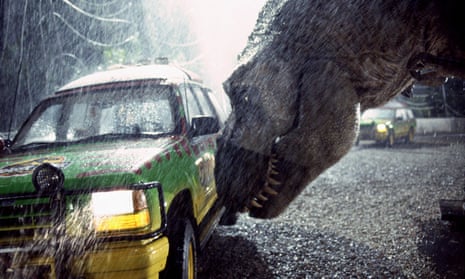The fearsome creatures of Jurassic World might chase you, kill you and rip you limb from limb, but there is one thing a T rex couldn’t do: stick out its tongue.
While Hollywood depictions of dinosaurs often show the creatures open-mouthed with tongues waving, researchers have discovered that many of them were probably tongue-tied, their tongues firmly anchored to the floors of their mouths and unable to waggle around.
Writing in the journal Plos One, palaeontologist Julia Clarke of the University of Texas at Austin and scientists from the Chinese Academy of Sciences describe how they explored the tongue-wagging abilities of dinosaurs by looking at fossils of a set of bony structures known as the hyoid that anchors the tongue in the mouth.
They also looked at fossils from extinct flying reptiles known as pterosaurs, and used both x-ray CT scanning and dissection techniques to look at the tongue anatomies of alligators and living birds – including the common pheasant, emu and redhead duck.
Birds have thin, mobile tongues and Y-shaped hyoids: two long, bony projections point towards the back of the mouth, and a central bony section sits in the front of the mouth with the tongue wrapped around it. Muscles attach to these bony projections, allowing birds to move their tongues and stick them out.
“We take birds for granted, but they have crazy tongues,” said Clarke. “The way that tongue is able to protrude so far is that these little skinny bones are super, super long – they are so long that in a hummingbird they wrap over the surface of the skull into the nose holes.
“We know that bird tongues are highly mobile, [but we were interested in] what is unique to them, when does that arise in Dinosauria.”
The team found that dinosaurs evolutionarily close to birds, such as microraptors, had hyoids similar to – albeit shorter than – those of modern birds. Elongated complex hyoids were also found in pterosaurs.
However, the majority of dinosaurs were found to have a simple, short hyoid rather like modern alligators, whose large, fleshy tongues are fixed to the floor of their mouths, with broad, short pieces of cartilage at the back rather than the longer bony support seen in birds. This, say the researchers, suggests dinosaurs could not have waggled their tongues, let alone stuck them out.
The exception, notes Clarke, was a group of plant-eating dinosaurs known as ornithischians, which includes beasts such as triceratops, who were found to have an unusual, complex hyoid.
While the team say it is not clear why some dinosaurs and birds evolved more mobile tongues, they suggest it comes down to feeding habits. Crocodiles and alligators – like many meat-eating dinosaurs – do little chewing, instead opting for a “tear and gulp” approach to table manners that does not require a mobile tongue. Herbivorous dinosaurs like triceratops needed to chew, while birds have a variety of feeding habits borne of their lifestyle.
“Once you have things that are eating seeds like birds, that are eating smaller prey items, then there seems to be elaboration of the tongue,” said Clarke. “Once there are wings instead of mobile forelimbs then I think there is more pressure on the tongue to participate in positioning food or food processing … moving food in the mouth.”
Stephen Brusatte, a palaeontologist at the University of Edinburgh who was not involved in the study, welcomed the research.
“It turns out that most dinosaurs have the very simple hyoid bones of modern crocodiles, which anchor a tongue that is pretty much glued to the floor of the mouth,” he said. “A cousin of T rex called Yutyrannus has this type of hyoid bone, as do almost all other dinosaurs, so it’s reasonable to infer that T rex did as well.”
“Those images in Jurassic Park of the T rex sticking its tongue out like a lizard as it prepares to devour its prey are probably wrong.”
